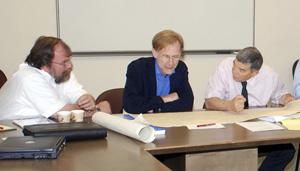30 May 2007

Yad Vashem Chairman Avner Shalev (right), ITS Director Reto Meister (center) and Head of Section Archives and Historical Research at the ITS Udo Jost look over a map of Bergen Belsen during working meetings at Yad Vashem today. (photo: Effi Neumann)
Officials from the Bad Arolsen Archives are at Yad Vashem this week preparing the groundwork for the transfer of millions of complex archive files to Yad Vashem, and to make them accessible to the public. In meetings with Yad Vashem Chairman Avner Shalev, as well as the heads and staff of the Yad Vashem Archives and IT divisions, Director of the International Tracing Service (ITS) Reto Meister, Head of Archives and Historical Research Section Udo Jost, and IT-System Administrator Michael Hoffman, are learning about Yad Vashem’s information systems and capabilities and sharing information about the content and organization of the ITS.
Chairman of Yad Vashem Avner Shalev welcomed the exchange of ideas. “I am delighted to welcome Messrs. Meister, Jost and Hoffman to Yad Vashem, and am pleased that the fruitful discussion taking place will help facilitate the transfer of material from Bad Arolsen to Yad Vashem. At this critical juncture, we are assessing the ramifications of bringing the Arolsen archive here, and preparing accordingly. The ITS decision to transfer material on embargo will assist us in continuing to ensure that researchers and survivors receive the information they need in a timely and efficient manner. In the coming weeks, we plan to send our experts to Bad Arolsen to study the materials and systems there, which will also facilitate the eventual transfer of material to Yad Vashem.”
The first transfer of digitized material is expected to take place by September 2007. This includes some 10 million images of documentation. The Bad Arolsen Archive contains information on some 17.5 million people. Some of the material will duplicate the 20 million pages of Arolsen documentation already housed in the Yad Vashem Archives since the 1950s.
ITS Director Reto Meister thanked Yad Vashem for the invitation to come to Jerusalem and gain a better understanding of the workings of Yad Vashem’s archive and information systems. “It’s always valuable to understand our partner’s experience and goals,” he explained. “More than any other place in the world, Yad Vashem is the natural repository for this material. Ultimately, our visit here will allow the material in Arolsen to be put to the best and widest use possible.”
At the annual meeting of the International Tracing Service (ITS) International Commission in Amsterdam earlier this month, the group decided to transfer - under embargo - digital copies of the Bad Arolsen Archives to member states of the International Commission. The transfer will allow the states to prepare for the opening of the Archives, while ratification of the relevant agreements (adopted May 2006) is pending. Once all 11-member states have ratified, the archives will be opened to researchers. Thus far, seven countries have ratified the agreements. This week’s meetings at Yad Vashem are meant to help both Yad Vashem and the Bad Arolsen archives adequately prepare to serve the public once the embargo on the material is lifted.
